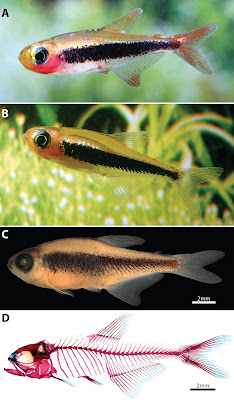 |
| Tucanoichthys tucano Géry & Römer, 1997 in Mattox & Conway, 2021. DOI: 10.3897/vz.71.e71886 |
Abstract
Miniaturization, the evolution of extremely small adult body size, is a common phenomenon across the lineages of freshwater fishes, especially in the Neotropics where over 200 species are considered miniature (≤26 mm in standard length [SL]). Close to 30% of all miniature Neotropical freshwater fishes belong to the family Characidae, several of which are of uncertain phylogenetic placement within the family. We investigate the skeletal anatomy of Tucanoichthys tucano, a species of uncertain phylogenetic position from the upper Rio Negro basin, reaching a maximum known size of 16.6 mm SL. The skeleton of Tucanoichthys is characterized by the complete absence of ten skeletal elements and marked reduction in size and/or complexity of others, especially those elements associated with the cephalic latero-sensory canal system. Missing elements in the skeleton of Tucanoichthys include those that develop relatively late in the ossification sequence of the non-miniature characiform Salminus brasiliensis, suggesting that their absence in Tucanoichthys can be explained by a simple scenario of developmental truncation. A number of the reductions in the skeleton of Tucanoichthys are shared with other miniature characiforms, most notably species of Priocharax and Tyttobrycon, the latter a putative close relative of Tucanoichthys based on molecular data.
Keywords: developmental truncation, miniaturization, Neotropics, Priocharax, skeleton, Tyttobrycon
George M. T. Mattox and Kevin W. Conway. 2021. Osteology of Tucanoichthys tucano Géry and Römer, An Enigmatic Miniature Fish from the Amazon Basin, Brazil (Teleostei: Characiformes: Characidae). Vertebrate Zoology. 71: 645-667. DOI: 10.3897/vz.71.e71886
